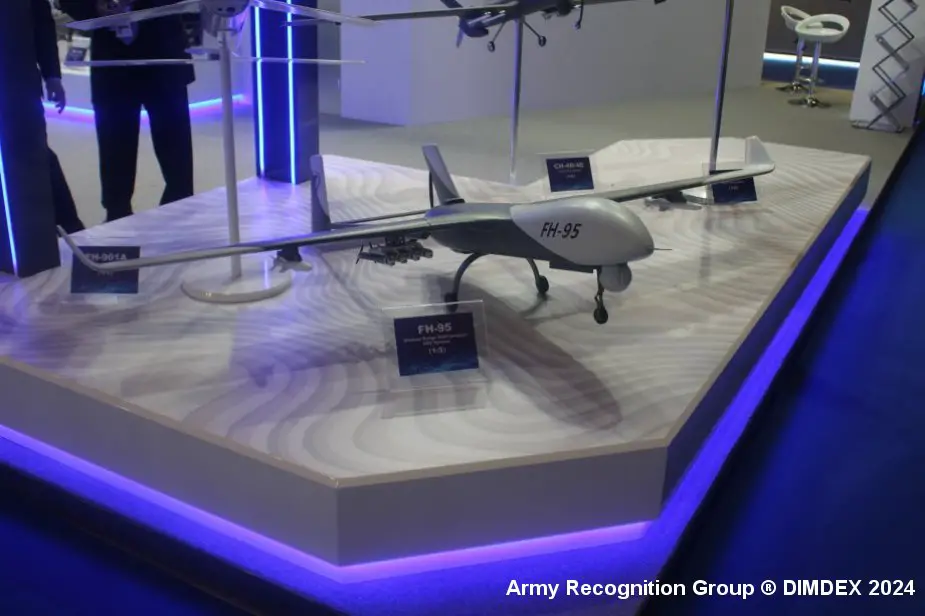Breaking news
DIMDEX 2024: China boosts drone leadership with new FH-95 electronic warfare UAV.
At the DIMDEX 2024 exhibition in Qatar, China once again showcases the development of its drone technology with the FH-95, an electronic warfare drone designed to analyze and collect sensor data from adversarial ground stations. This innovation aims to support both manned and unmanned Chinese combat aircraft in conducting deep strikes on the battlefield.
Follow Army Recognition on Google News at this link

The FH-95 presented by the China Aerospace Science and Technology Corporation at DIMDEX 2024 (Picture source: Army Recognition)
Developed by the China Aerospace Science and Technology Corporation, the FH-95 is capable of fulfilling a variety of missions, including strike, reconnaissance, and electronic warfare in highly contested combat environments.
Capable of flying for over 24 hours, the FH-95 is described as adding "another dimension" to drone deployment thanks to its electromagnetic warfare capabilities. With a maximum takeoff weight of 1000 kg and a payload of 250 kg, it can operate up to an altitude of 42,000 feet, making it particularly suited for a wide range of operations. Technical specifications of the FH-95 include a maximum flight time of 12 hours, a takeoff weight of 850 kg, and a maximum payload of 200 kg. Equipped with wheeled landing gear, it can take off and land on airport runways, thus minimizing geographical limitations for its deployment.
A notable feature of the FH-95 is its versatility as an electronic warfare platform, capable of carrying various payloads for reconnaissance, precision strike, and electronic jamming. This is complemented by reconnaissance methods integrating visible light, infrared, and SAR imaging, as well as the ability to carry a range of conventional weapons for specific strikes.
The FH-95 drone could also serve as an early warning platform, leveraging advances in radar warning receiver (RWR) components that can be fitted onto lighter platforms. This capability is crucial for mission effectiveness in complex and remote terrains.
In the context of combat operations, the FH-95 is envisioned to operate in tandem with the FH-97 drone, offering a powerful combination for electromagnetic jamming and the suppression of enemy air defenses. This strategic approach suggests that the FH-97 could serve as decoys to expose enemy air defense positions, allowing the FH-95 to neutralize enemy radars with anti-radiation missiles, thereby facilitating operations for manned fighter jets.
China has become a major player in the global military drone market, capitalizing on the production of advanced yet affordable drone systems. Notably, in the Middle East, Saudi Arabia and the United Arab Emirates have acquired Chinese armed drones such as the Wing Loong II.
Chinese drones are often perceived as offering a good balance between cost and capabilities, with flexibility in sales agreements. Nonetheless, they provide considerable technological capabilities, including conducting precise strikes.
By focusing on the development and production of advanced drones like the FH-95 and FH-97, China aims to enhance its electronic warfare capabilities. Integrating electromagnetic jamming technologies and anti-radiation missiles, along with the ability to conduct joint operations between drones and manned aircraft, China seeks not only to refine its military doctrine but also to reduce its reliance on imports while promoting self-sufficiency and the export of its defense technologies.
Defense News March 2024























